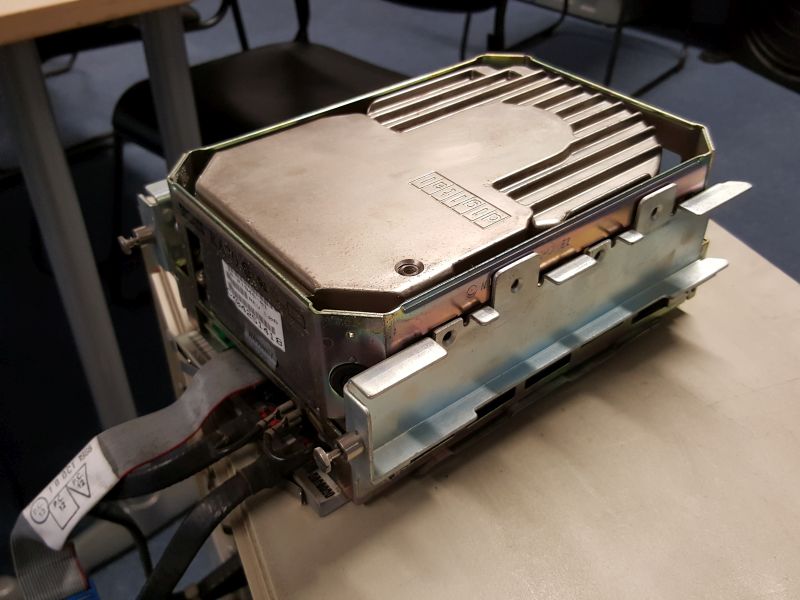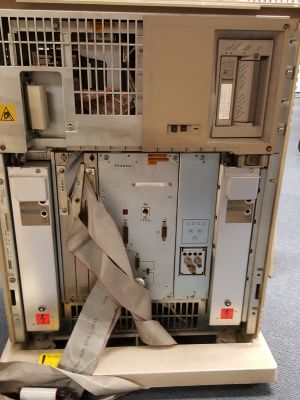I wrote this page over the winter of 2016-2017 as I wanted to
include pictures along with questions for the knowledgable folk at
DECUServe and also to give it wider appeal.
Last update 17/1/17
Previous experience
I have had slight brushes with DEC and its equipment over the
years. Perhaps under slightly different circumstances I'd have ended
up with them in Reading instead of automotive in Witney. If DEC2
popped into existence tomorrow I'd go knocking on their door and question
why later.
At University (note I don't use the word "Uni") though most
of my proper computer interaction was through IBM 4341 and 3084 we
(engineering) had MicroVAXes running some UNIX . A BSD or Ultrix ?
The only definite think I remember was the M shell that had history,
something that was pretty unusual at the time.
I had a normal 9-5 job at Lucas Body Systems in Witney. The VAX
there (an 11 series I guess) had a wodge of audio cards and
associated wiring and was used to develop the talking Maestro
instrument pack that everybody loved so much. The term "I.T." didn't
exist as I picked up the role of "network manager" for the incoming
Netware server that replaced it alongside my official title of
"design engineer". I allowed and indeed encouraged a rather good
collection of games alongside the development tools on the Netware
server A Mitac 386DX. As I remember Mitac had a service arrangement
with a household vacuum cleaner manufacturer back them. That's more
service than you get these days. We kept the DEC band printer and it
was some years before we were allowed to buy a laser (only after a
colour dotty matrix). The former VAX room now only contained the 386
but a friend found it useful for respraying his Kawasaki GT550's
panels.
By the mid 90s I had thrown in my "safe" job (Lucas Witney closed
down a couple of years later anyway) and started contracting returning to
Cambridge. Slightly by accident (borrowed a VHDL book whilst working
on GSM DSP in Melbourn) I got into "modelling" and that included a DEC-supplied
one of the StrongARM for which I had slight interaction with Rich
Witek.
A couple of decades on
the Centre for
Computing History, I had meant to visit in Haverhill, moved
rather closer. (For our American friends close is something I can
pedal to in twenty minutes and getting in the car is nominally a
weekly activity.) An unexplained urge to get back into big computer
stuff had me visit
the Jim Austin
Collection east of York. That place is stunning and houses the
university's old 3084 with a book value which I'm sure was quite
theoretical in this case, of $8m. A quick mention
of Roger
Broughton's virtual museum and the very
fine Hercules System/370+
emulator.
Volunteering
My only previous brush with volunteering was at
the Museum of
Technology on the river. It's a great place for steam engines
and the like but also some electronics particularly PYE stuff and
also a working mercury rectifier.
On my first day as a volunteer at
the CCH, a
privilege which allows me to wander in to the kitchen virtually
unnoticed and make a cup of tea, Bryan suggested I take a look at
these three VAXen. He can be seen running the
PDPs here.
I have since gathered certain people amuse themselves seeing how
"new" volunteers cope with exploding power supplies as it isn't
uncommon to get smoke firing things up after decades. In reality I
am of of those silicon to soldering iron to switching power supplies
to functional programming types and was rather disappointed that all
three machines powered up uneventfully. I had just spent time
reading the schematics of PDP (not VAX) power supplies too.
Three machines
At the same time as familiarising myself with VAX hardware, the MMJ
connector and boot switches and commands I have started on VMS,
tinkering with OpenVMS on SIMH and DECUServe. There's a VMS book on
the shelf next to the BBC Basic books and of course heaps online. The
anal part of me notes useful kernel features present in modern BSDs
including Darwin and MS Windows but NOT penguin-based kernels.
 The VAXen live in a cosy currently cool corner of the museum next to
arcade machines and the PDPs and checking the room is free I wheel
them into the 80s classroom to work on them and also grab the amber
screen VT220 'cos that's far more fun than shoving a USB serial port
into a modern computer isn't it. (The building next door has
recently been acquired so this area is becoming less cramped.) Best
not mention how long it took to work out how to remove the front
panels of these boxes.
The VAXen live in a cosy currently cool corner of the museum next to
arcade machines and the PDPs and checking the room is free I wheel
them into the 80s classroom to work on them and also grab the amber
screen VT220 'cos that's far more fun than shoving a USB serial port
into a modern computer isn't it. (The building next door has
recently been acquired so this area is becoming less cramped.) Best
not mention how long it took to work out how to remove the front
panels of these boxes.
Working downwards from eager to maybe dead. For the second machine
in particular cards have been removed, contact cleaner applied and
various connectors and devices re-seated. Also run with cards
removed. The first two machines are Q-Bus I think.
VAX server 4000 ?
The model number is from memory rather than a picture. I'd describe
this machine as eager. Unfortunately the disk bays are empty but it
does have two working ethernet interfaces and I can network boot
OpenBSD off either (NetBSD spewing messages about an interrupt). Not
terribly exciting.

Though the connectors made me think SCSI looking up the part number
on the termiators says DSSI. Which explains why the mini D-type
genders aren't as expected.
VAX server 4500
Its single disk didn't spin let alone seek before we opened and
glared at it. Now it tries though there's still no OS and it (the
disk) does sound just a little scary. What is the Port A Port B disk
interface in the second picture ?


The main problem with this machine is unreliability in during
countdown tests. As often as not it locks up at test 17.

As far as I
can tell this is sensitive to temperature (better when cold) and
also whether the front panel that covers the ribbons between CPU and
two memory boards, is present. Yes these have been subjected to
contact cleaner.
VAX station 3520
Has an RGB output but the presence of the RGB card surely wouldn't stop
something coming out on the MMJ console would it ?

This is the machine that has had the least amount of attention. Does
the diagnostic LED count down ? Is there one ? Can't remember.
Unlike the above two I assume Q-BUS machines this one has what
Wikipedia suggests is an M-bus. Is that right ? Here is its storage
interface.

Is that to SCSI on the left ? I see a 10Mhz bus adaptor device
bottom left. But unfortunately because of the different bus to the
other machines I still can't see a way to make use of my pile of
fully working* SCSI disks in the 400MB-2GB range.
The machine itself has a couple of Fujitsu and one Micropolis
drive. I remember Micropolis from when they made drives of a size
nobody else did. Our Netware server started with one.
* One of the Conners I tested spun up, spun down a few seconds later
then a controller chip blew its top.
Conclusions so far
Could maybe network boot at least the first machine from another
running OpenVMS on SIMH but though this has been fun I have to admit
these aren't ever going to be visually interesting except for maybe
the third machie if only it weren't so ... dead. Inspired by modern
software I'm still learning VMS.
email me
my home page
 The VAXen live in a cosy currently cool corner of the museum next to
arcade machines and the PDPs and checking the room is free I wheel
them into the 80s classroom to work on them and also grab the amber
screen VT220 'cos that's far more fun than shoving a USB serial port
into a modern computer isn't it. (The building next door has
recently been acquired so this area is becoming less cramped.) Best
not mention how long it took to work out how to remove the front
panels of these boxes.
The VAXen live in a cosy currently cool corner of the museum next to
arcade machines and the PDPs and checking the room is free I wheel
them into the 80s classroom to work on them and also grab the amber
screen VT220 'cos that's far more fun than shoving a USB serial port
into a modern computer isn't it. (The building next door has
recently been acquired so this area is becoming less cramped.) Best
not mention how long it took to work out how to remove the front
panels of these boxes.





